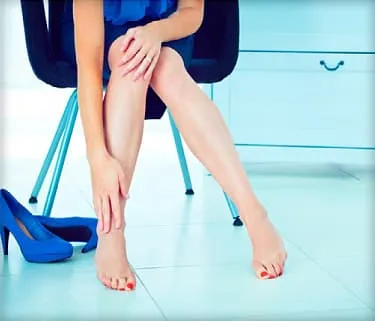Sclerotherapy is a medical procedure used to eliminate varicose veins and spider veins. Sclerotherapy involves an injection of a solution (generally a salt solution) directly into the vein. The solution irritates the lining of the blood vessel, causing it to collapse and stick together and the blood to clot. Over time, the vessel turns into scar tissue that fades from view.
Sclerotherapy is a proven procedure that has been in use since the 1930s.

Candidates for Sclerotherapy
Prior to sclerotherapy, you will have an initial consultation with a dermatologist or vascular medicine specialist who will decide if you're a good candidate for the procedure.
You are not eligible if you are pregnant. You can have sclerotherapy if you take birth control pills. If you have had a blood clot in the past, your eligibility will be decided on an individual basis, and will depend on the overall health of the area needing treatment as well as the reason for the clot.
Veins that are potentially usable for future heart bypass surgery will generally not be considered for sclerotherapy, unless they are already deemed unusable.
How Sclerotherapy Is Done
In most cases of sclerotherapy, the salt solution is injected through a very fine needle directly into the vein. At this point, you may experience mild discomfort and cramping for one to two minutes, especially when larger veins are injected. The procedure itself takes approximately 15 to 30 minutes.
The number of veins injected in one session depends on the size and location of the veins, as well as the general medical condition of the patient.
Sclerotherapy is performed in the doctor's office by a dermatologist or a surgeon and requires that you do not do any aerobic activity for a few days after the procedure.
What to Do Before Sclerotherapy
Prior to sclerotherapy, you should avoid certain medications. Talk to your doctor about all medicines (including over-the-counter drugs, herbs, and dietary supplements) you are taking. If you need to take an antibiotic before sclerotherapy, contact your doctor. No lotion should be applied to the legs before the procedure.
Some doctors recommend avoiding aspirin, ibuprofen (such as Advil, Motrin, and Nuprin) or other anti-inflammatory drugs for 48-72 hours before sclerotherapy. Tylenol, however, should not affect this procedure.
Side Effects of Sclerotherapy
You may experience certain side effects after sclerotherapy. There are milder effects, such as itching, which can last for one or two days after the procedure. Also, you may experience raised, red areas at the injection site. These should disappear within a few days. Bruising may also occur around the injection site and can last several days or weeks.
Other Sclerotherapy Side Effects Include:
- Larger veins that have been injected may become lumpy and hard and may require several months to dissolve and fade.
- Brown lines or spots may appear at the vein site. In most cases, they disappear within three to six months, but they may also last indefinitely.
- Neovascularization -- the development of new, tiny blood vessels -- may occur at the site of sclerotherapy treatment. These tiny veins can appear days or weeks after the procedure, but should fade within three to twelve months without further treatment.
Should any of the following side effects occur, contact your doctor immediately. These include:
- Inflammation within five inches of the groin
- A sudden onset of a swollen leg
- Formation of small ulcers at the injection site
Allergic reactions to the fluid that's injected may occur at the time of the injection and are rarely serious. If you have a history of allergies, you have a greater chance of experiencing an allergic reaction to the agents. A minor allergic reaction will cause itching and swelling. To avoid any serious complications, your doctor will likely test the agents on a small area before applying the solutions to a larger area.
If you have any concerns or questions following this procedure, you should contact your doctor.
What Happens After Sclerotherapy
After sclerotherapy you will be able to drive yourself home and resume your regular daily activities. Walking is encouraged.
You will be instructed to wear support hosiery to "compress" the treated vessels. If you have compression hosiery from previous treatments, you are encouraged to bring them with you to be certain they still have adequate compression. Department store support stockings will not be adequate if a heavy compression stocking is needed. Your doctor's office can recommend where to purchase heavy compression stockings.
Following the injections, avoid aspirin, ibuprofen, or other anti-inflammatory drugs for at least 48 hours. Tylenol may be used if needed.
Also, you should avoid the following for 48 hours after treatment:
- Hot baths
- Hot compresses
- Whirlpools or saunas
- Direct exposure to sunlight
Showers are permitted, but the water should be cooler than usual. The injection sites may be washed with a mild soap and tepid water.
Sclerotherapy Effectiveness
Studies have shown that as many as 50%-80% of injected veins may be eliminated with each session of sclerotherapy. Less than 10% of the people who have sclerotherapy do not respond to the injections at all. In these instances, different solutions can be tried. Although this procedure works for most patients, there are no guarantees for success.
In general, spider veins respond in three to six weeks, and larger veins respond in three to four months. If the veins respond to the treatment, they will not reappear. However, new veins may appear at the same rate as before. If needed, you may return for injections.
Insurance Coverage for Sclerotherapy
Insurance coverage for sclerotherapy varies. If your varicose veins are causing medical problems such as pain or chronic swelling, your insurance may offer reimbursement. If you are pursuing sclerotherapy for cosmetic purposes only, your insurance carrier most likely will not provide coverage. You should discuss your concerns with your doctor. If you have questions, call your insurance company, which may request a letter from your doctor concerning the nature of your treatment and medical necessity.

